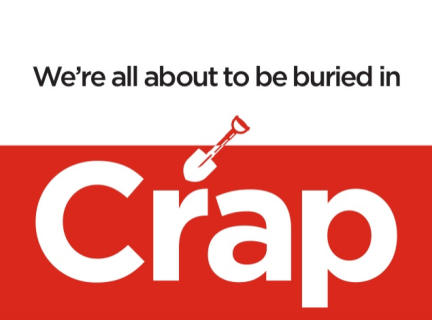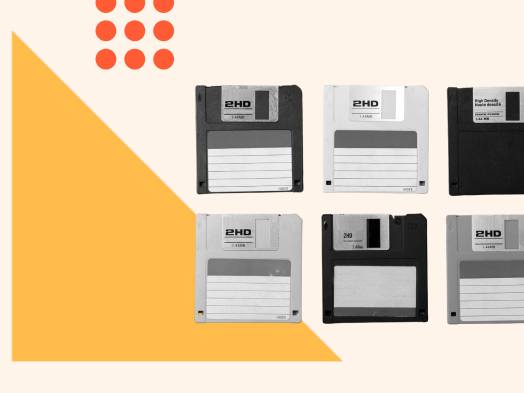When we at Velocity Partners published our latest SlideShare rant, “Crap: The content marketing deluge,” we got a big, big response.
The rant is all about how the rush to content marketing in every industry will make it harder and harder for your content to rise above the noise -- and how the only defense is to build a Great Content Brand.
If you didn't see the slideshow, take a quick look. It's light on copy, you should be able to breeze through it quite quickly.
All caught up? Great.
The content trickle is not yet a flood.
A lot of people responded by saying that the "content deluge" isn’t on its way; it’s already here. Which made me think.
In many ways, of course, it’s true -- using content for marketing is well underway in many markets. The top vendors have active blogs. Many have published ebooks. Others have produced videos about the issues shaping the market. But I’m still convinced that the pretty dramatic increase in content we’ve already seen is really just the first trickle before the coming tsunami. Here's why:
1) More markets are discovering the power of content.
We marketers are hyper-sensitive to the content in our own space, but there are many markets out there that are still dipping their toes in the content waters (and we all know what the toe bone is connected to).
2) More vendors in each market are entering the Content Arms Race.
Once a single vendor creates a buzz with their sexy new ebook, the others are never far behind. They can’t afford to be.
3) Each competitor needs to generate more and more content.
An ebook or white paper every six months might have been good enough last year. This year, it will be one a month. Per persona. And next year, the content machines really start ramping up.
4) Every marketing discipline is becoming content-powered.
Search, social, email, web advertising ... they’ve all discovered that success depends on great content. The stuff that earns inbound links, shares, and clicks. In short: here come the agencies.
5) We’re all getting more efficient.
What used to be an alien discipline is now developing its own set of processes and metrics. So marketing departments can create more content with the same budgets (for better and, often, for worse).
If this sounds daunting, here’s an even more sobering thought:
In the content marketplace, you’re not just up against your direct competitors. You’re up against everyone who’s producing content on the same issues.
If you’re a software vendor, your content isn’t just fighting for Google shelf space against the four or five competitors who do the same things you do. You’re also up against every reseller, integrator, consultant, analyst, advisor, association, pundit, blogger, and smart-arse with a point of view and a Wordpress, SlideShare or YouTube account.
And don’t forget the former kings and queens of the content castle: journalists and editors (they haven’t all taken jobs as Head of Branded Content yet).
Or the Tyrannosaurus Rex of content: Wikipedia.
You’re competing against all of these in an epic battle for the scarcest resource on Earth: people’s attention. And the thin slice of attention that might be called your addressable mindshare -- the part that people reserve for the issues you’re talking about -- is getting smaller and smaller. Because every prospect is being targeted by even more content across many more issues that have nothing to do with you.
Now, for the really scary part.
To your prospects, the first few waves of content purported to be written for the sole purpose of helping them do their jobs were really welcome.
But when the deluge hits, all this content is going to start to look a hell of a lot like something we’ve all become really, really good at ignoring. It’s going to look like advertising. (I know, I know: even hearing the word makes your eyes turn into Xs and your thumb reach for the zap button.)
By now, you’re probably poking around for the little vial of cyanide all marketers keep under their tongues.
So it’s time for some better news.
A Lesson From History
Back in the fifties, TV advertising was new (as was TV).
The first companies to jump into this exciting new medium discovered something big. They discovered that they could use TV ads to build something called brands, and that these brands would soon become the company’s most valuable assets.
Even the not-so-great products benefited from the new brand glow. And the great products turned into unstoppable brands that generated massive profits for decades.
Well, we’re in a similar place right now. There’s a window of opportunity for marketers to create what the ‘Crap’ rant mentioned above calls "Great Content Brands." If you build such a brand now, before the tidal wave hits, your content will survive the impact. Because you will have secured a space in the minds of your prospects as, “Those guys who put out that great stuff.” You’ll be known in the market as real thought leaders: intelligent contributors to the conversations around the issues that matter most.
It’s still possible to build a Great Content Brand. But it’s going to get harder and harder -- just as it got harder for TV advertisers to build great new soap brands.
So stop reading this, and go build a Great Content Brand. Do it by working hard. Not just to create more content but to create great content. When the waters come, and they will come, you’ll be bobbing around on the surface instead bumping along the bottom.
Doug Kessler is co-founder and creative director of Velocity, the B2B content marketing agency. He’s written a lot about content marketing, including the Content Marketing Strategy Checklist and the B2B Marketing Manifesto.
Content Marketing




-1.webp)
![How to create a content style guide [+ free guide & examples]](https://53.fs1.hubspotusercontent-na1.net/hubfs/53/image1-May-07-2024-07-15-58-1152-PM.webp)







